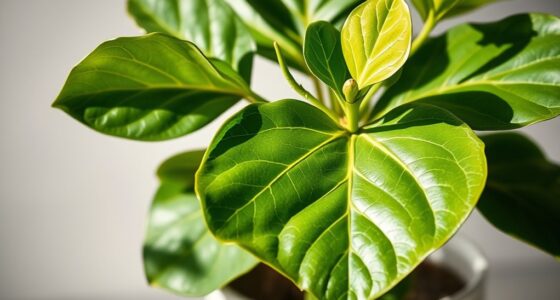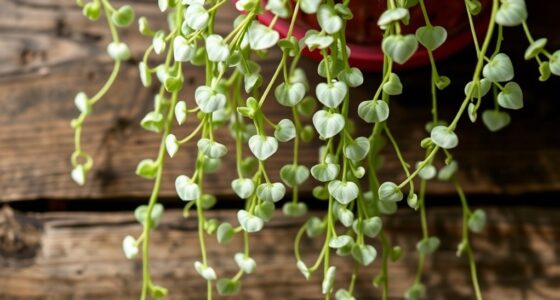To craft your indoor oasis, focus on creating a space with lush succulent arrangements, hanging planters, and textured textile art to add depth and relaxation. Position plants near natural light and incorporate cozy seating with soft lighting and warm rugs to foster a tranquil atmosphere. Grouping plants and using decorative containers enhances visual interest. Keep exploring for more ideas to turn your corner into a serene, inviting retreat you’ll love spending time in.
Key Takeaways
- Incorporate succulent arrangements in decorative pots for texture and visual interest.
- Use hanging planters or vertical gardens to maximize space and add depth.
- Enhance the atmosphere with textile art as textured backdrops for a calming vibe.
- Place plants near natural light sources to ensure healthy growth and vibrant greenery.
- Add cozy seating, soft lighting, and textured rugs to create a tranquil, inviting retreat.

Have you ever wondered how to transform your indoor space into a lush, calming retreat? Creating a cozy plant corner is easier than you think, especially when you focus on a few key elements that bring nature inside. One effective way is to incorporate a succulent arrangement, which adds texture and visual interest without requiring much maintenance. Succulents are perfect for indoor environments because they thrive in bright, indirect light and need minimal watering. When arranging succulents, consider using decorative pots or containers that complement your décor. Grouping them together creates a focal point that feels both intentional and inviting. You can even mix different varieties to add a splash of color and variety, making your plant corner more dynamic.
To elevate your indoor oasis further, hang some planters from the ceiling or wall. Hanging planters are a fantastic way to maximize space while adding a touch of elegance and greenery at various heights. They draw the eye upward, creating a sense of depth and openness in your space. Choose planters made from materials like macramé, ceramic, or metal, depending on your style, and fill them with trailing plants like pothos or string of pearls. These cascading plants soften the edges of your space and add a flowing, natural feel. Hanging planters also allow you to place your succulents or other plants in spots that are hard to access, making your plant care routine more manageable. Incorporating float mounting textile art techniques around your plant corner can add a unique textured backdrop and enhance the relaxing atmosphere.
Positioning your succulent arrangement near natural light sources, such as windows or skylights, ensures they stay healthy and vibrant. Pair this with hanging planters placed in spots that catch the light, and you’ll create a lively, bright nook that invites you to relax. Incorporate elements like cozy seating, soft lighting, or textured rugs around your plant corner to enhance the calming atmosphere. The goal is to craft a space that feels like a personal retreat, where you can unwind after a busy day.
Frequently Asked Questions
What Are the Best Low-Light Plants for Indoor Corners?
If you’re looking for low-light plants for indoor corners, consider options like pothos, snake plant, and ZZ plant. These plants thrive in dim spaces, help with air purification, and make a decorative arrangement that brightens up any corner. You won’t need direct sunlight, making them perfect for creating a relaxing indoor oasis. Plus, they’re easy to care for, so you can enjoy a lush, healthy space without much effort.
How Often Should I Water My Indoor Plants?
You should establish a consistent watering schedule to maintain proper plant hydration. Typically, water your indoor plants when the top inch of soil feels dry, which varies based on the plant type and environment. Avoid overwatering, as it can lead to root rot. Check your plants regularly and adjust your watering routine accordingly, ensuring they stay healthy and thriving in your indoor space.
What Soil Type Is Ideal for Indoor Plants?
For your indoor plants, choose a well-draining soil type that prevents waterlogging. Look for a mix that includes soil amendments like perlite or vermiculite, which enhance plant drainage. These amendments help roots breathe and avoid root rot. Avoid heavy, clay-based soils. A lightweight, aerated potting mix supports healthy growth and keeps your indoor oasis thriving, ensuring your plants get the right balance of moisture and aeration.
How Can I Prevent Pests in My Plant Corner?
To prevent pests in your plant corner, you should focus on pest prevention strategies. Regularly inspect your plants for signs of pests, and keep your space clean. Using organic treatments like neem oil or insecticidal soap can help control any infestations early. Quarantining new plants before adding them to your collection also reduces the risk. Consistent maintenance and natural remedies are key to keeping pests at bay.
What Are Tips for Maintaining Humidity Levels?
Imagine your plant corner as a cozy rainforest, needing just the right humidity control to thrive. You can mist your plants regularly with misting techniques, creating a gentle rain that keeps moisture in the air. Use a humidity meter to monitor levels, aiming for 50-60%. If needed, place a tray of water nearby or use a humidifier. These steps guarantee your plants stay lush and happy, like a thriving jungle.
Conclusion
By creating your indoor oasis, you’re not just adding plants—you’re transforming your entire space into a lush, serene sanctuary that could rival the most tranquil jungle on Earth. Imagine having a slice of paradise so calming, it feels like stepping into a dream every time you enter. With the right plants and care, your relaxing plant corner becomes an unbeatable refuge, an oasis so breathtaking, it’ll make the outside world seem like just a distant memory.









